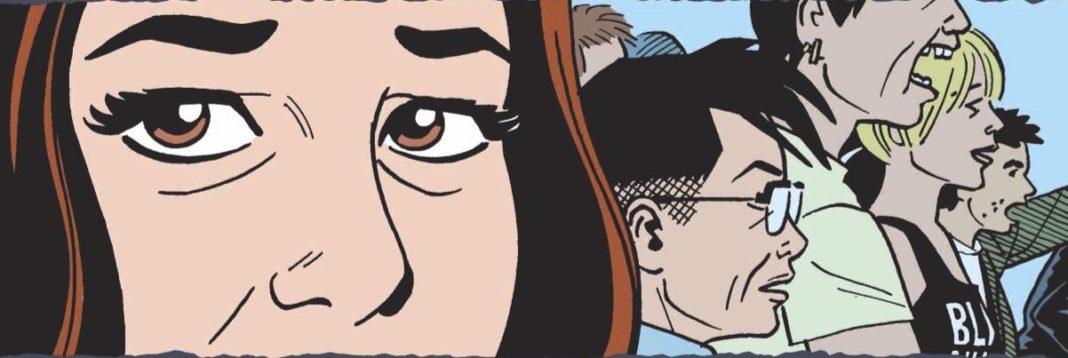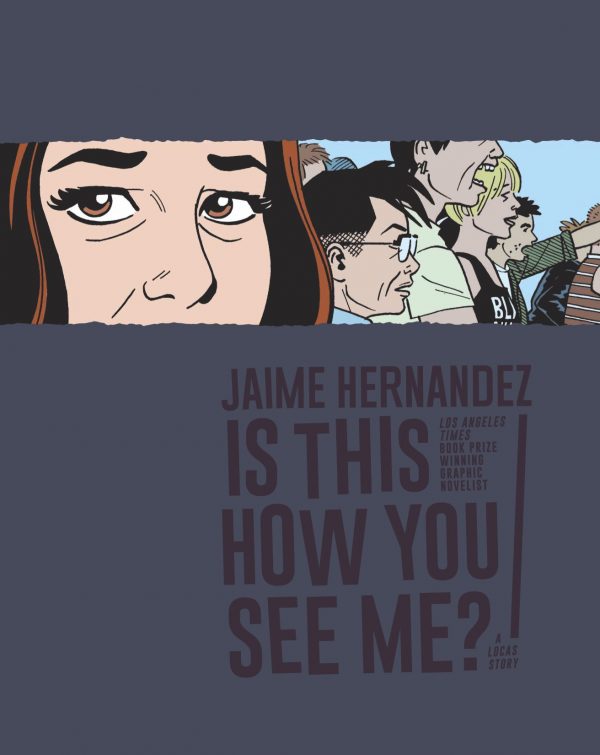Is This How You See Me?
By Jaime Hernandez
Fantagraphics Books
So when did I first encounter Perla Chascarillo? It was something like 35 years ago. At the time she was a prosolar mechanic assisting Rand Race and having crazy adventures with former wrestling champ Rena Titanon, but she was really a punk kid from a Latino neighborhood in California called Hoppers.
Perla is better known as Maggie. She was a comic book character and she made an impression at the time largely because she was the only thing like her back then. For one thing, we were about the same age and even if she was fictional, she actually seemed the same age, not like the lame attempts at young people you saw in DC or Marvel comics. She was in the punk scene in her hometown. I was never a punk, wouldn’t ever claim to be, but I liked a bunch of the music and I knew punks and I never saw any of that reflected in comics besides Maggie’s world. And she was bisexual which, again, I would never claim to be, but seeing that in a comic in the early ‘80s?
As I said, Maggie was the only thing like her back then, and she opened up a one-of-a-kind fictional world that she shared with people like her best friend and sometimes girlfriend Hopey and Izzy, part older sister figure, part broken soul who looms over their life like a specter. And then all the others — Ray, Izzy, Doyle, Terry, you name them, a collection of weirdos, druggies, drunks, sex workers, artists, musicians, and several lovely humans, all inhabiting the Latino community, the punk community, the queer community. These were not places typically explored in early 80s comics. People who didn’t fit in were not the focus of comics.
And women were definitely not the focus of any comic back then, at least any comic that treated them as real characters of depth. That just didn’t happen. There was nothing else like Maggie and her community in all of comics and I feel lucky to be the exact age I am because I got to encounter these characters in real time, as they unfolded, and also as I unfolded. Looking back on it, Jaime Hernandez knew a lot more about life and what being a human is really like than I ever understood at the time.
Which is why reading Jaime Hernandez’s Is This How You See Me? which brings Maggie and Hopey up to date is so weird. There they are, as old as me, with different lives, but still Maggie and Hopey. Not the same people at all. And yet. We’re all old now. What the hell?
I never go to high school reunions. Never once. No interest. Is this what it’s like? That’s kind of the conceit that Hernandez frames Is This How You See Me? It’s a reunion of the neighborhood punks in Hoppers, a night of all the old bands performing and all the old crowd showing up, and Maggie and Hopey go to check it out with mixed feelings. They bicker a lot. They did 35 years ago. This is one of the things that hasn’t changed.
Other things have. Hopey, once a hurtful hothead who seemed incapable of keeping her shit together, now seems almost wise. Like she’s paid attention to her life and took lessons from it. Like she’s decided to let things slide because drama is just an interruption to the important things. Who’d have thought? Especially because Maggie, it turns out, is kind of stunted, actually. When she was young, she seemed so poised to break away from the old nonsense, like she just had a ways to go and she was going to be this proactive, solid person who walked through life with a ballsy resolve. But she sort of got stuck in the transition moment.
Now, I’ve read the comics between the original run and this reunion book, and on one hand, none of this Maggie stuff is a revelation. It’s all there. But something in the way Hernandez presents this story, it functions as a summation of what he’s been presenting to us. A statement of sorts. You could literally not read a Maggie and Hopey comic since its original run ended in 1996 and then you could read this and it would make perfect sense.
There are numerous thematic threads in the story — this book is rich with them, and they unfold through Hernandez’s use of flashbacks to Maggie and Hopey’s younger, wilder days. The understanding that the times you cherish the most weren’t the necessarily safest of times or the smartest of times or the noblest of times, but it’s in those situations where you feel the freest when you are young. The idea that how you remember yourself isn’t necessarily who you are — you control your own narrative to yourself, but you’re a part of other narratives that you have no say in. The fear that your contributions will be overlooked. The suspicion that the young don’t really understand the history of even the things they love, but instead prefer the legend. The unavoidable reality that the mode of your rebellion will someday be made fuzzy at best and commodified at worst. The fact that people become mundane, ordinary creatures, and that’s really okay. The truth that happiness is a good thing to work for, and there needs to be no greater ultimate secret to life than that.
How lucky we are that these themes are being explored by Jaime Hernandez in a book that is a culmination of 37 years of narrative. That’s what makes it special. These are lived-with characters and lived-with situations, and if you’ve been a part of that in some way, these themes mean as much in regard to yourself and your own life as they do in Hernandez’s comic. They are a reason for self-reflection as well as appreciation of Hernandez’s epic.
And there is much to appreciate in Hernandez. This is not news. This is well-established. His clean, animated lines comprise some of the most influential comics art ever. His story-telling style pulls from all the comics that people 35 years ago shrugged off as the silly stuff, like Archie, but he appropriates the techniques from those to elevate them into something that gets inside you.
He doesn’t spell out every detail in his storytelling, and some of his most important details happen between the panels. He never shows them to you. He lets them unfold disjointed sometimes like you’re overhearing a conversation in a loud bar and only catching every other word of it. You think you know what’s between those panels, but do you?
When Maggie and Hopey were first introduced 37 years ago, it established a pattern that the two characters have stuck to these decades later. They could never quite, for very long, be in the same place at the same time. Through most of their stories, one was somewhere else and, as a consequence, though they are often referred to as Maggie and Hopey stories — the colloquial alternative to calling them Locas stories — they’re Maggie stories most of the time.
Though Hopey does take center stage at various points, it’s the exception rather than the rule, and she often exists as a ghost that looms in Maggie’s psyche as she moves through life apparently without a plan and often in an oppositional mode to doing whatever thing might make her life better.
Hernandez takes that long-running pattern and uses it to his advantage here, giving the characters what feels like a farewell — at the very least, a thematic one — by finally bringing them together in one place one more time and having them struggle to function in that space, and having Maggie contend with other ghosts coming at her. And like life itself, it’s fun, it’s bittersweet, and it doesn’t completely end without regrets.
At the same time, life doesn’t end right there. As the series has proven, there are no thematic ends. Life moves on past the point where everything ties together. I suspect I’ll encounter Maggie and Hopey again sometime and the only thing I can tell you for sure is that we will all be even older.












Thanks — I had no idea this was out; and I was about to begin re-reading the Locas stories in my old LOVE & ROCKETS from the beginning. IS THIS HOW YOU SEE ME? will be a great carrot for when I finish.
Fuckin’ Doyle, man.
Comments are closed.